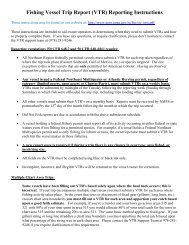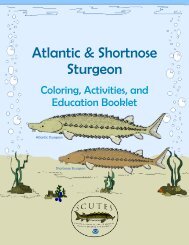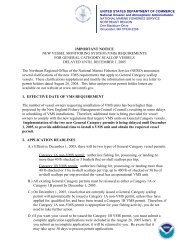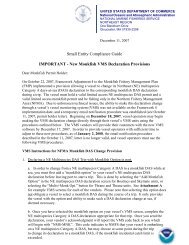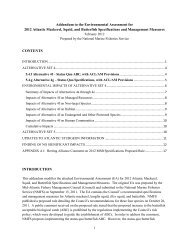modifications to the harbor porpoise take reduction plan - Northeast ...
modifications to the harbor porpoise take reduction plan - Northeast ...
modifications to the harbor porpoise take reduction plan - Northeast ...
Create successful ePaper yourself
Turn your PDF publications into a flip-book with our unique Google optimized e-Paper software.
compliance, thus increasing <strong>the</strong> effectiveness of <strong>the</strong> HPTRP. Expanded pinger areas provide<br />
potential benefits over expanded closure periods by preventing potential increased economic<br />
effects, or by avoiding <strong>the</strong> shift of effort and bycatch in<strong>to</strong> adjacent open areas. However, <strong>the</strong><br />
option <strong>to</strong> expand pinger requirements in<strong>to</strong> <strong>the</strong> Mid-Atlantic, even when <strong>the</strong> discussion was<br />
limited <strong>to</strong> <strong>the</strong> Waters off New Jersey, was not favorably received by HPTRT members. The<br />
effectiveness of pingers for reducing <strong>harbor</strong> <strong>porpoise</strong> bycatch in Mid-Atlantic waters has not<br />
been evaluated. However, limited testing has <strong>take</strong>n place in North Carolina on <strong>the</strong> effects of<br />
acoustic devices on bottlenose dolphins. The dolphins observed during recent studies reacted<br />
differently <strong>to</strong> pingers than <strong>harbor</strong> <strong>porpoise</strong>s do in that <strong>the</strong>ir initial reactions are relatively small<br />
and <strong>the</strong> pingers do not appear <strong>to</strong> deter <strong>the</strong>m from <strong>the</strong> vicinity of <strong>the</strong> nets (Cox et al., 2003).<br />
Ra<strong>the</strong>r, it is possible that pingers alert bottlenose dolphins <strong>to</strong> <strong>the</strong> presence of <strong>the</strong> nets. In a recent<br />
study involving bottlenose dolphin depredation in <strong>the</strong> Spanish mackerel gillnet fishery, a new<br />
type of acoustic deterrent device called <strong>the</strong> SaveWave was tested <strong>to</strong> determine its effects on<br />
bottlenose dolphins. While a very low amount of depredation was observed during <strong>the</strong> study, <strong>the</strong><br />
results indicated that <strong>the</strong> SaveWave devices did not deter <strong>the</strong> dolphins from <strong>the</strong> nets. Ra<strong>the</strong>r, <strong>the</strong><br />
devices appeared <strong>to</strong> alert dolphins <strong>to</strong> <strong>the</strong> presence of <strong>the</strong> net (<strong>the</strong> researchers observed increased<br />
echolocation in <strong>the</strong> presence of active SaveWave devices), which could help reduce<br />
entanglement risk but could also increase depredation as <strong>the</strong> devices did not seem <strong>to</strong> deter <strong>the</strong><br />
dolphins away from <strong>the</strong> nets (Read et al., 2006).<br />
28



